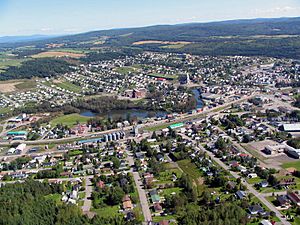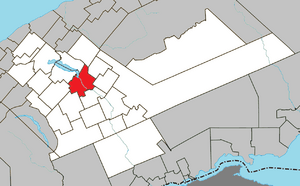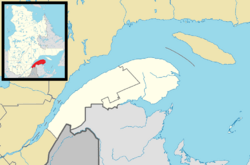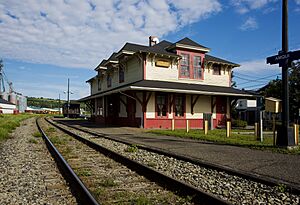Amqui facts for kids
Quick facts for kids
Amqui
|
||
|---|---|---|
|
City
|
||

Aerial view of Amqui
|
||
|
||

Location within La Matapédia RCM.
|
||
| Country | ||
| Province | ||
| Region | Bas-Saint-Laurent | |
| RCM | La Matapédia | |
| Settled | 1870s | |
| Constituted | January 16, 1991 | |
| Area | ||
| • Total | 126.80 km2 (48.96 sq mi) | |
| • Land | 120.02 km2 (46.34 sq mi) | |
| Population
(2021)
|
||
| • Total | 5,999 | |
| • Density | 49.6/km2 (128/sq mi) | |
| • Pop 2016-2021 | ||
| • Dwellings | 3,015 | |
| Time zone | UTC−5 (EST) | |
| • Summer (DST) | UTC−4 (EDT) | |
| Postal code(s) |
G5J
|
|
| Area codes | 418 and 581 | |
| Highways | ||
Amqui is a town in eastern Quebec, Canada. It is located at the bottom of the Gaspé peninsula in a region called Bas-Saint-Laurent. The town sits where two rivers, the Humqui and Matapédia Rivers, meet. Amqui is the main town of the La Matapédia Regional County Municipality, which is like a local government area. You can get to Amqui easily by using Quebec Route 132.
The name Amqui comes from the Mi'kmaq word amgoig. This word has a few meanings, like "the place to have fun" or "place of amusement and pleasure." Another Mi'kmaq name, Amkooĭk, means "boggy," which describes the wet land. Some people think the name comes from the swirling water where the two rivers join. However, the most likely reason is that Amqui was a place where Indigenous peoples gathered for special events called pow wows.
Contents
History of Amqui
Amqui was originally the land of the Mi'kmaq. In 1694, the area was given to Charles-Nicolas-Joseph D'Amours by Louis de Buade de Frontenac. D'Amours passed away in 1728, and his family did not claim the land. Because of this, the area remained wild and undeveloped for a long time.
Early Development
In the 1830s, construction began on the Kempt Road. This was an important military road connecting Quebec and the Maritimes. It was finished in 1833 and helped open the area for new settlers. But the biggest change came in the 1870s with the building of the Intercolonial Railway. This railway really helped Amqui grow.
Town Growth and Name Changes
- In 1879, Amqui got its first post office.
- By 1881, a religious mission called Saint-Benoît-Joseph-Labre was started. It was named after Benedict Joseph Labre.
- Amqui became known as a great spot for salmon and trout fishing by 1884.
- In 1889, the mission became a full parish. The next year, it officially became the Parish Municipality of Saint-Benoît-Joseph-Labre.
- In 1907, the village part of the municipality separated and became the Village Municipality of Saint-Benoît-Joseph-Labre.
- The village was renamed Amqui in 1948.
- In 1961, Amqui officially became a town.
- In January 1991, the Parish Municipality of Saint-Benoît-Joseph-Labre joined with the Town of Amqui.
Geography of Amqui
Amqui is located south of the Saint Lawrence River. It sits in the Matapédia Valley, which was created by the Chic-Choc Mountains. This valley was formed millions of years ago by glaciers. The area has gentle slopes, and the Matapédia River winds through it from northwest to southeast. As mentioned before, Amqui is right where the Humqui and Matapédia rivers meet.
Location and Nearby Places
Amqui is about 415 kilometers (258 miles) northeast of Quebec City. It's also 345 kilometers (214 miles) west of Gaspé and 80 kilometers (50 miles) north of New Brunswick.
Other towns close by include:
- Rimouski, about 105 kilometers (65 miles) to the west.
- Mont-Joli, about 70 kilometers (43 miles) to the west.
- Matane, about 65 kilometers (40 miles) to the north.
Amqui is also near Sayabec (25 km east) and Causapscal (20 km northwest). These are the next biggest towns in La Matapédia. Amqui shares borders with several other smaller towns and villages. The small community of Couturval is also part of Amqui.
Amqui's Climate
Amqui has a climate called a humid continental climate. This means it has four distinct seasons. Because it's surrounded by the Chic-Choc Mountains, Amqui has special weather conditions. These include long, snowy winters and warm, humid summers.
| Climate data for Amqui, Quebec (1981-2010): 183m | |||||||||||||
|---|---|---|---|---|---|---|---|---|---|---|---|---|---|
| Month | Jan | Feb | Mar | Apr | May | Jun | Jul | Aug | Sep | Oct | Nov | Dec | Year |
| Record high °C (°F) | 11.0 (51.8) |
12.0 (53.6) |
16.7 (62.1) |
28.5 (83.3) |
32.8 (91.0) |
33.3 (91.9) |
33.5 (92.3) |
33.9 (93.0) |
32.2 (90.0) |
24.5 (76.1) |
18.9 (66.0) |
17.8 (64.0) |
33.9 (93.0) |
| Mean daily maximum °C (°F) | −9.9 (14.2) |
−7.8 (18.0) |
−1.7 (28.9) |
6.1 (43.0) |
14.2 (57.6) |
20.2 (68.4) |
22.8 (73.0) |
21.5 (70.7) |
16.1 (61.0) |
9.1 (48.4) |
1.2 (34.2) |
−5.9 (21.4) |
7.2 (44.9) |
| Daily mean °C (°F) | −15.0 (5.0) |
−13.4 (7.9) |
−7.0 (19.4) |
1.2 (34.2) |
8.1 (46.6) |
13.9 (57.0) |
17.0 (62.6) |
15.8 (60.4) |
10.9 (51.6) |
4.7 (40.5) |
−2.4 (27.7) |
−10.1 (13.8) |
2.0 (35.6) |
| Mean daily minimum °C (°F) | −20.0 (−4.0) |
−18.9 (−2.0) |
−12.2 (10.0) |
−3.8 (25.2) |
2.0 (35.6) |
7.6 (45.7) |
11.2 (52.2) |
10.1 (50.2) |
5.7 (42.3) |
0.2 (32.4) |
−5.9 (21.4) |
−14.3 (6.3) |
−3.2 (26.3) |
| Record low °C (°F) | −40.0 (−40.0) |
−38.9 (−38.0) |
−35.0 (−31.0) |
−28.5 (−19.3) |
−12.2 (10.0) |
−4.5 (23.9) |
1.0 (33.8) |
−2.2 (28.0) |
−6.0 (21.2) |
−13.5 (7.7) |
−26.0 (−14.8) |
−34.4 (−29.9) |
−40.0 (−40.0) |
| Average precipitation mm (inches) | 85.3 (3.36) |
69.5 (2.74) |
66.5 (2.62) |
75.9 (2.99) |
89.5 (3.52) |
93.3 (3.67) |
102.1 (4.02) |
100.5 (3.96) |
81.6 (3.21) |
88.0 (3.46) |
98.2 (3.87) |
81.8 (3.22) |
1,032.2 (40.64) |
| Average snowfall cm (inches) | 75.4 (29.7) |
63.5 (25.0) |
51.7 (20.4) |
30.3 (11.9) |
3.0 (1.2) |
0.0 (0.0) |
0.0 (0.0) |
0.0 (0.0) |
0.2 (0.1) |
7.2 (2.8) |
46.7 (18.4) |
66.7 (26.3) |
344.7 (135.8) |
| Average precipitation days (≥ 0.2 mm) | 18.3 | 15.0 | 14.6 | 13.6 | 16.2 | 14.5 | 15.7 | 15.8 | 16.9 | 16.5 | 16.4 | 17.9 | 191.4 |
| Average snowy days (≥ 0.2 cm) | 17.4 | 13.9 | 12.8 | 6.3 | 1.0 | 0.0 | 0.0 | 0.0 | 0.2 | 2.7 | 9.8 | 16.8 | 80.9 |
| Source: Environment Canada | |||||||||||||
Amqui's Population and People
|
|||||||||||||||||||||||||||||||||||||||||||||||||||||||||||||||
According to the 2021 Census, Amqui had a population of 5,999 people. These people lived in 2,846 homes. The total number of homes in Amqui was 3,015. This population number was a small decrease of 2.9% from 2016. The town covers a land area of 121.02 square kilometers (46.73 square miles). This means there were about 49.6 people living in each square kilometer in 2021.
| Canada census – Amqui community profile | |||
|---|---|---|---|
| 2016 | 2011 | 2006 | |
| Population: | 6,178 (-2.3% from 2011) | 6,322 (+1.0% from 2006) | 6,261 (-3.3% from 2001) |
| Land area: | 121.17 km2 (46.78 sq mi) | 120.81 km2 (46.65 sq mi) | 120.81 km2 (46.65 sq mi) |
| Population density: | 51/km2 (130/sq mi) | 52.3/km2 (135/sq mi) | 51.8/km2 (134/sq mi) |
| Median age: | 48.8 (M: 48, F: 49.7) | 47.2 (M: 46.2, F: 48.0) | 44.2 (M: 43.8, F: 44.4) |
| Total private dwellings: | 2,992 | 2,925 | 2,836 |
| Median household income: | $49,728 | $49,702 | $40,733 |
| Notes: Population in 1996: 6,800 (+4.3% from 1991) - Population in 1991: 6,518 – References: 2016 2011 2006 earlier | |||
Most people in Amqui speak French. About 6,090 out of 6,120 residents speak French as their main language. Also, about 12% of the people can speak both French and English.
| Mother tongue | Population | Percentage |
|---|---|---|
| French | 5,755 | 99.3% |
| English | 15 | 0.3% |
| English and French | 10 | 0.2% |
| Other languages | 10 | 0.2% |
Important Buildings and Travel
Amqui Railway Station
The Amqui railway station is a two-story building built in 1904. It is used by Via Rail trains, including the Ocean route. The station is very important because it helped transport farm products and wooden goods from Amqui. It also became a key stop for trains traveling between Montréal and Halifax, and between Montréal and Gaspé (though the Gaspé service stopped in 2013).
The Canadian government protects this building under the Heritage Railway Stations Protection Act since 1988. This means it's a special historical building. The station's design is unique for its time. It has two floors, with the station master and their family living on the top floor.
Famous People from Amqui
- Alfred Belzile - a politician and farmer.
- Sébastien Caron - a goaltender (hockey goalie) who played for the Nashville Predators.
- Cathy LeFrançois - a professional bodybuilder.
See also
 In Spanish: Amqui para niños
In Spanish: Amqui para niños




